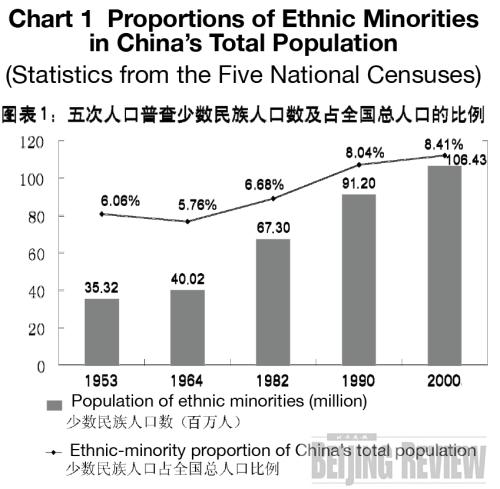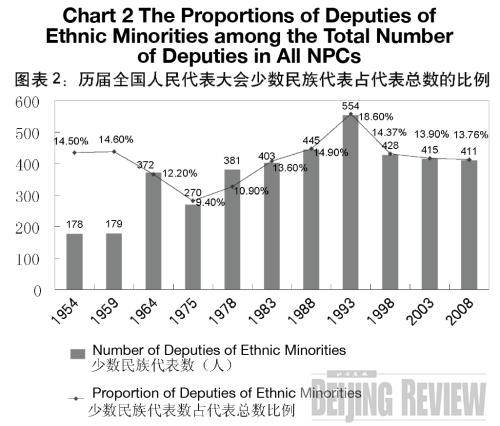|
The legal system of regional ethnic autonomy is being constantly improved. The Common Program of the Chinese People's Political Consultative Conference (CPPCC), passed by the CPPCC in 1949, actually served as a provisional constitution. It defined the system of regional ethnic autonomy as a basic policy of the New China. In 1952, the Central People's Government issued the Program for the Implementation of Regional Ethnic Autonomy, which included clear provisions on such important issues as the establishment of ethnic autonomous areas and the composition of organs of self-government, as well as the right of self-government for such organs. In 1954, the Constitution adopted by the NPC institutionalized the system in the form of basic law, and has ever since adhered to this system. In 1984, on the basis of summing up the experience of practicing regional ethnic autonomy, the Second Meeting of the Sixth NPC adopted the Law on Regional Ethnic Autonomy. As a result, the country's system of regional ethnic autonomy has become more complete in terms of policy, system and law. The Law on Regional Ethnic Autonomy is the basic law in the implementation of the relevant provisions of the Constitution. It defines the relationship between the Central Government and the ethnic autonomous areas, as well as the relationship among different ethnic groups in ethnic autonomous areas. Its legal effect is not limited to ethnic autonomous areas only; every individual in China and all state organs must abide by and implement this law. In 2001, in consideration of actual conditions when the socialist market economy was established, the Standing Committee of the NPC made revisions to the Law on Regional Ethnic Autonomy. The Provisions of the State Council on Implementation of the Law of the People's Republic of China on Regional Ethnic Autonomy, issued by the State Council in 2005, define the duties of governments at higher levels to support and help the organs of self-government in ethnic autonomous areas.
Ethnic autonomous areas effectively exercise the right of self-government. The self-government organs in ethnic autonomous areas are the people's congresses and people's governments of autonomous regions, autonomous prefectures and autonomous counties. These organs have the following rights under the law:
—Independent management of the ethnic group's internal affairs in its autonomous area. People of various ethnic origins in autonomous areas are entitled to vote and stand for election, as provided for in the Constitution and other laws, and, by electing deputies to the people's congresses at various levels and establishing self-government organs, exercise their democratic rights to manage the internal affairs of their own ethnic groups and their autonomous areas. The chairmen and vice chairmen of the standing committees of the people's congresses of all 155 ethnic autonomous areas in China are citizens of the ethnic groups exercising regional autonomy in the areas concerned. The heads of all autonomous regions, autonomous prefectures and autonomous counties are all citizens of the ethnic groups exercising regional autonomy in the areas concerned. Other members of the people's governments of the autonomous areas include an appropriate number of members of the ethnic group(s) exercising regional autonomy as well as members of other ethnic minorities. The functionaries of the working departments subsidiary to the organs of self-government are composed in a similar fashion.
—Enjoyment of the right to formulate autonomous regulations and separate regulations. The Law on Regional Ethnic Autonomy stipulates that, besides enjoying the same rights as other local state organs, people's congresses in autonomous areas have the right to enact autonomous regulations and separate regulations in the light of the political, economic and cultural characteristics of the ethnic group or ethnic groups in the areas concerned. The Legislation Law of the People's Republic of China stipulates that the autonomous regulations and separate regulations may contain provisions which have been adapted on the basis of existing laws or administrative regulations to suit the particular conditions of the ethnic group concerned. By the end of 2008, the ethnic autonomous areas had formulated 637 autonomous regulations and separate regulations, as well as adapted or supplemented regulations to relevant laws. In the light of the particular situation in each area, the ethnic autonomous areas have adapted related provisions in several laws, including the Marriage Law, Inheritance Law, Election Law, Land Law and Grassland Law, or provided supplementary regulations to such laws.
—Independent arrangement, management and development of economic construction. Organs of self-government of autonomous areas are entitled to, in accordance with legal provisions and the characteristics of local economic development, rationally adjust the relations of production and economic structure of the said areas, manage enterprises, public institutions under their jurisdiction, manage and protect their local natural resources in accordance with the law, and manage local finance. The self-government organs of all ethnic autonomous areas formulate their own plans and measures for economic and social development, and arrange their own infrastructure projects by following the guidance of the overall state plan for national economic and social development, while at the same time taking into consideration local conditions. Ethnic autonomous areas may, in accordance with the relevant state provisions, open ports for foreign trade after obtaining approval from the State Council. Ethnic autonomous areas may enjoy state preferential policy treatment as regards foreign trade.
—Independent development of cultural and social undertakings. The self-government organs of ethnic autonomous areas may determine their educational plans, establishment of schools, educational system, forms by which schools are run, curricula and methods of enrollment, in accordance with the principles concerning education and legal provisions of the state. The self-government organs of ethnic autonomous areas may independently develop cultural undertakings with ethnic characteristics, including literature, art, news, publishing, radio and TV broadcasting, and movies. They may organize relevant entities to collect, edit, translate and publish books related to the history and culture of the ethnic groups; to protect scenic spots, historical sites, valuable cultural relics and other important aspects of the local cultural heritage; and to inherit and carry forward the traditional culture of ethnic groups.
V. Accelerating the Economic and Social Development of the Ethnic Minorities And Minority Areas
Adhering to common prosperity and development of all ethnic groups is the fundamental stance of China's ethnic policy.
The Constitution stipulates, "The state does its utmost to promote the common prosperity of all ethnic groups in the country." The Law on Regional Ethnic Autonomy stipulates that it is a legal obligation of the higher-level state organs to help the minority areas accelerate their development. Over the years, the state has made it a major part of national development to promote the economic and social progress of the ethnic minorities and minority areas, and has worked out from time to time policies and measures to this end.
Before the founding of the New China in 1949, most minority areas had an extremely low level of productivity, backward economic and social development, and extremely poor infrastructure. There was not an inch of railway in Xinjiang, not a single highway in Tibet, and in mountainous Yunnan, horses, elephants and suspension cables were all the locals could rely on for traveling or carrying goods. People of the ethnic minorities engaged mainly in traditional agriculture and animal husbandry. Some places were still in the primitive "slash-and-burn" state. In some areas, people still used wooden and stone tools; and iron tools were not yet widespread. The ethnic minorities led a life full of misery. Life was even worse for those living in the mountainous and desert areas, where a dearth of food and clothing was common. For months almost every year they would run out of grain and had to survive on wild fruits, and in the harsh winter they had nothing to keep out the cold but straw capes. All this hindered the progress of the ethnic minorities. Some of them were on the verge of extinction, with the Hezhen numbering only some 300 people at the time of the founding of the New China. It was on such an extremely backward basis that the social and economic construction of the ethnic minorities and minority areas began in the New China.
The CPC and the Central Government have always supported the development of the ethnic minorities and minority areas. When the New China was established, the Chinese Government made it a basic task to rid all ethnic groups of poverty and enable them to lead a better life. Since the adoption of the reform and opening-up policies in the late 1970s, the state has focused on economic construction, given top priority to development, made increasing efforts and carried out several significant measures to quicken the advance of the ethnic minorities and minority areas. Over the years, the ethnic minorities and minority areas have all along upheld the spirit of self-reliance and hard working, coupled with assistance from economically advanced parts of China and state preferential policies, striven to build better homes for themselves. Thanks to the concerted efforts of the entire nation, the ethnic minorities and minority areas have seen one leap forward after another in their economic and social progress, completely got rid of stark poverty and backwardness, and entered a stage unparalleled in history.


(To be continued) |
